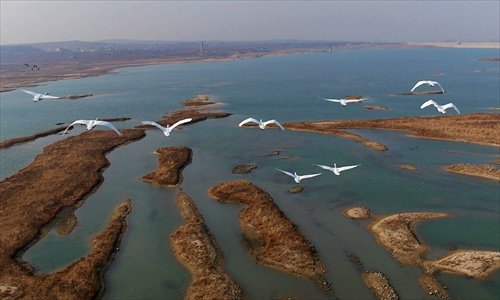Qinghai Lake drone ban reveals risky trend in wildlife photography
Qinghai Lake aircraft ban reveals risky trend in wildlife photography

A photo taken by a drone shows swans flying across Ziyang Lake in Qingdao, East China's Shandong Province on December 8. The shoot was arranged by the local government to inspect the migrating birds. Photo: CFP
Sleek and omnipresent drones have been hitting the headlines recently, either because of stunts like airlifting wedding gifts to film stars, or due to their ability to help cover disasters such as the Shenzhen landslide or the Tianjin explosions.
Now they have caught public attention again after reports came out saying authorities are banning the use of drones to photograph wildlife around Qinghai Lake, China's largest inland lake, due to concerns over animal welfare.
Many amateurs are disturbing or scaring wildlife by flying drones close to animals to get a shot, a Qinghai Lake administrator told the Global Times on Monday.
The lake, located in the Qinghai-Tibet Plateau in western China, is home to more than 100,000 birds of various kinds, including swans, geese, ducks and gulls.
A witness told the Qinghai Province-based Xihai Metropolis Daily earlier this month that a drone flew just a few centimeters away from the heads of sleeping swans this month, and the birds flew away in shock. The news sparked public outcry online with the Xihai Metropolis Daily reporting that "the amount of swans is dramatically shrinking after they were disturbed by the drones."
He Yubang, director of the Qinghai Lake National Reserve Administration, told the Global Times on Tuesday that while the growing use of drones does disturb wildlife at Qinghai Lake, the number of swans is not decreasing and if there was any decrease it would likely be caused by the weather and climate change instead.
To protect wildlife, drone flights have been banned over Qinghai Lake, and warnings have been posted in the area that demand photographers stay at least 500 meters away from animals, He said.
"Swans and other wildlife in the region are very sensitive due to the cold and changeable winter weather, and such animals easily become scared when drones approach," added He.
He pointed out that birds in their mating season suffer the most from drones, as they might fail to tend to their eggs if they are scared by drones.
Ornithologist Fang Hua told the Xinhua News Agency that some visitors have also used car horns and fireworks to scare birds in order to get photos of them in flight.
The authorities have increased the frequency of patrols around the lake to control visitor behavior, Xinhua reported on January 12.
Drone shoot
Drones are gaining increasing popularity among photographers and aircraft enthusiasts in China. An entry-level drone equipped with a camera produced by Chinese drone maker DJI that costs 2,999 yuan ($455) was bought 2,025 times online in January alone.
"Drones can approach the center of a lake to take photos of birds and follow them to record a video," Lu Xiuming, a freshman at Huazhong University of Science and Technology in Central China's Hubei Province, told the Global Times on Monday. "However, I need to stay at least 10 meters away to make sure not to scare them away and to ensure they won't hit my aircraft," Lu said, describing his experience shooting birds in May.
Hou Min, a deputy director of the Aircraft Owners and Pilots Association of China's experimental aircraft committee, explained that drones are easier to operate and cheaper than telephoto lenses, and many amateurs use drones out of curiosity.
Presently, people using drones to photograph animals do not need to report to the local authorities, Hou added.
However, birds get frightened when a drone flies around them, so the chance of a photographer getting a clear photo is slim, another drone photographer surnamed Wu told the Global Times.
Li Qiang, leader of the bird-watching branch of the Friends of Nature, a Chinese environmental protection organization, told the Global Times that they do not recommend the use of drones in wildlife photography.
It's hard to tell whether those who photograph or observe animals with a drone are just drone enthusiasts or animal lovers, and drone enthusiasts with little knowledge of wildlife are likely to disturb or even hurt animals, said Li. He added that the recreational use of drones to photograph animals should be restricted.
Photographers are advised to lie down on the ground so swans do not notice them, not to make any noise and stand up only after the swans leave, Zhang Haidong, an experienced photographer told the Xihai Metropolis Daily.
Newspaper headline: Drones make swans duck